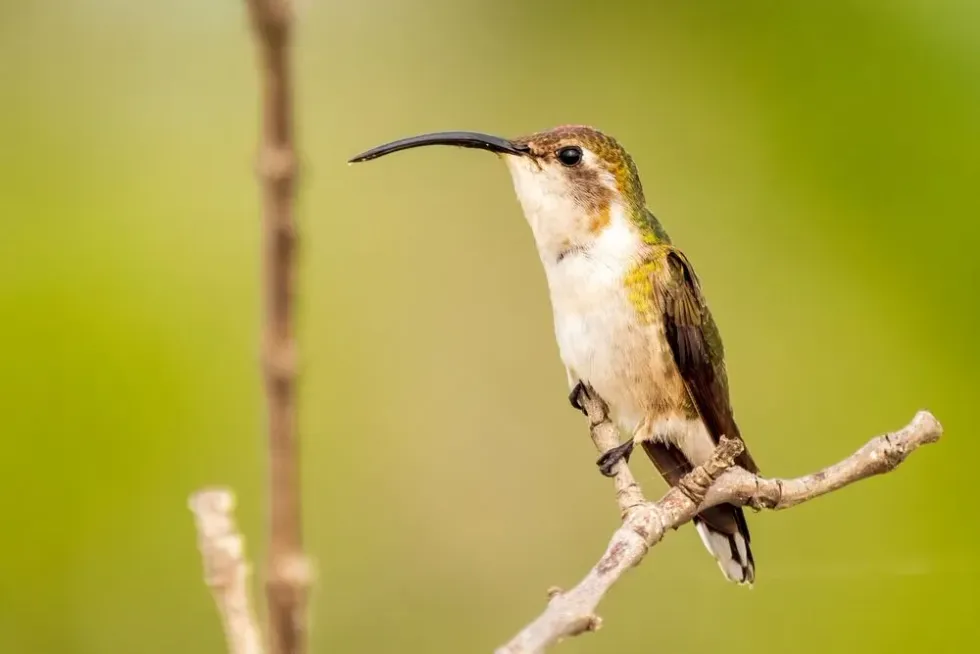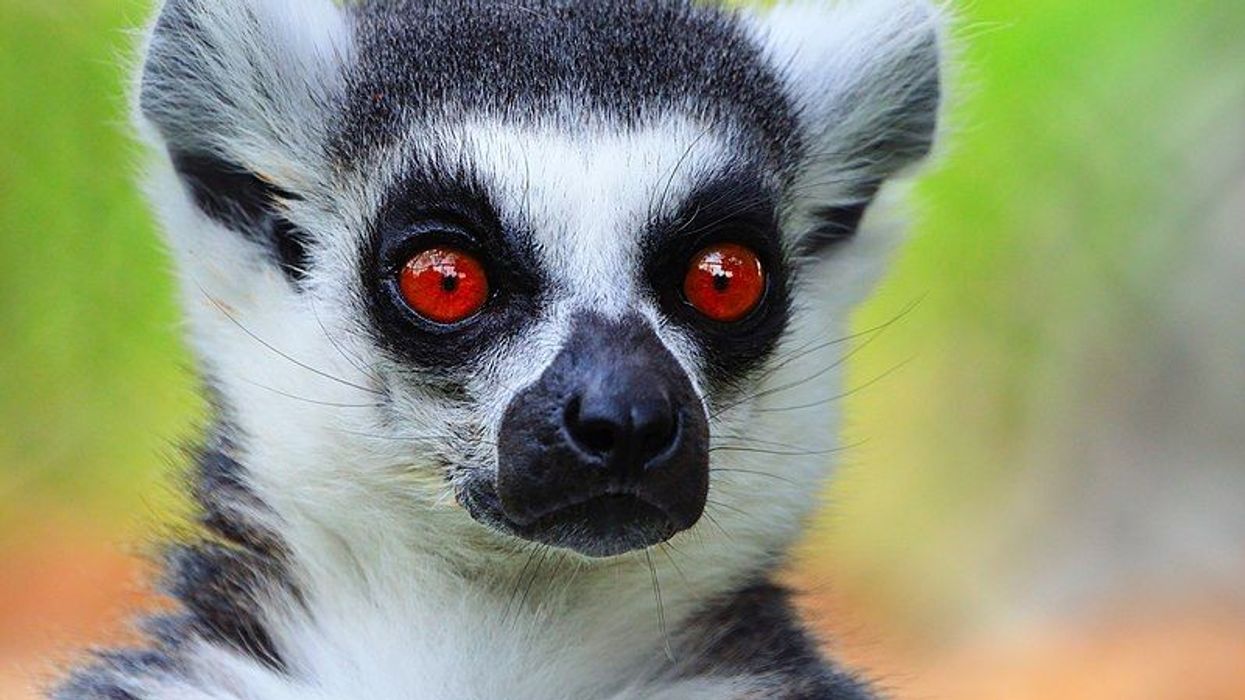The Mexican sheartail (Doricha eliza) is a beautiful little hummingbird that is very active and restless in its behavior. Named for their forked tails, these are some of the most interesting birds in the world.
They have very long bills and their diet mainly consists of nectar.
This species of bird is endemic to Mexico and its distribution is divided into two populations: one set of these birds is found in Veracruz and the other is found in the northern part of the Yucatán peninsula.
These two populations were once suspected to be two different species because of some differences in their plumages and ecological characteristics. Their distribution in the northern Yucatán peninsula is more than in Veracruz, possibly because the birds in the peninsula are found breeding in urban areas as well.
The Veracruz population lives only in undisturbed areas, of which there is becoming a shortage due to cultivation and residential development in its habitat. However, both of these populations and thus, the species as a whole, face a number of threats and their population is decreasing at an alarming rate.
Having said that, there are steps being taken for the conservation of this amazing bird.
For more amazing and surprising facts about other birds, check out our martial eagle facts and brown creeper facts pages.
Mexican Sheartail Interesting Facts
What type of animal is a Mexican sheartail?
The Mexican sheartail (Doricha eliza) is a type of bird, more specifically, a hummingbird.
What class of animal does a Mexican sheartail belong to?
This species of bird belongs to the class Aves and the family Trochilidae, with the scientific name Doricha eliza.
How many Mexican sheartails are there in the world?
The total population of this species of birds in the world is estimated to be 2,500-9,999 individuals. Only less than 2,500 Mexican sheartails are found in the Veracruz part of its population and the rest of their distribution is found in the north Yucatán peninsula.
Due to this, they have been given the status of Near Threatened and are now included in several conservation programs.
Where does a Mexican sheartail live?
The Mexican sheartail is endemic to Mexico and is found in two locations in that country: Veracruz and the coastal area in the north Yucatán peninsula. They do, however, seasonally migrate within their own range in Mexico.
What is a Mexican sheartail's habitat?
The Yucatán population is found in the coastal area on the north of the peninsula, along with tropical deciduous forests and mangroves. They are known to breed in gardens and urban areas in that range whereas the distribution in Veracruz is found only in undisturbed dry deciduous forests and other vegetation, far away from the coast.
Who do Mexican sheartails live with?
Mexican sheartails are known for living independently their whole life. The male bird only associates with the female bird to mate but they separate immediately after and the female bird cares for the young alone.
How long does a Mexican sheartail live?
The lifespan of the Mexican sheartail (Doricha eliza) is not yet known. However, its generation length is 4.2 years, which refers to the number of years between two consecutive generations of a species.
How do they reproduce?
After mating, the male bird leaves the female bird, who protects and cares for the young ones alone. The female bird chooses the location of the nests in a shrub or the branch of a tree. Two eggs are laid in a cup-shaped nest made from lichens, cotton, and spider webs.
The nest has to be constantly protected by the females from ants, owls, spiders, praying mantises and snakes as they might attack the nest and take over it. Thus, most of the breeding responsibilities are taken over by the female birds.
What is their conservation status?
This species faces a number of threats to its already declining population, which is spread across a very small range in Mexico. Some of the threats are loss of habitat due to cultivation, residential development, and tourism. Thus, it has been given the status of Near Threatened by the IUCN Red List.
Mexican Sheartail Fun Facts
What do Mexican sheartails look like?
The Mexican sheartail (Doricha eliza) is a sexually dimorphic species, which means that the males and females of this species differ in their appearance. The males are mainly characterized by their bright iridescent pink-purple throats and their long forked tails with white tips.
The wing feathers and some underparts are muddy green and black. The females look similar to the males but lack the purple throats and instead have a white throat, chest, and belly. The forked tail in females is significantly shorter than males but they have similar wing feathers.
Both males and females have a very long, dark bill that is slightly curved. The juveniles, before they mature, look very similar to the females.
How cute are they?
With their restless behavior and beautiful mud green plumage, they can rightfully be considered one of the cutest birds in the world.
How do they communicate?
The bird call of this species consists of sharp and short whistle notes. Like most other birds of the world, the Mexican sheartail (Doricha eliza) probably uses this bird call to establish its territory and protect the flowers it feeds on.
How big is a Mexican sheartail?
These birds are very small and the length of a Mexican sheartail can range from 3.3-3.9 in (8.5-10 cm) which makes them about four times smaller than a hooded crow.
How fast can a Mexican sheartail fly?
The exact speed with which this species of birds fly is not yet known. However, other hummingbirds, like Anna's hummingbirds, have been known to achieve the maximum speed of 60 mph (98 kph)!
How much does a Mexican sheartail weigh?
The Mexican sheartail (Doricha eliza) is a species of very light birds and an average adult of the species weighs about 0.085-0.092 oz (2.4-2.6 g).
What are the male and female names of the species?
There are no specific names for the male and female birds of this species.
What would you call a baby Mexican sheartail?
A baby bird of this species can be called a chick when it has just hatched out of its egg. They may be called juveniles when they are growing but have not grown into a mature adult yet.
What do they eat?
The main part of the diet of this species is nectar from flowers, which they take from the flowers with their long tongues while hovering over the flower. They prefer colorful flowers that have a high sugar content and grow on shrubs, trees, and herbs.
Most of them are red in color, tubular-shaped, and heavily rely on this species of hummingbirds for their pollination.
This species will aggressively protect these flowers from other birds or insects. Other than nectar, they are also known to feed on small insects, which they catch mid-flight or from leaves and branches; they are also sometimes seen drinking water from fountains and sugar water that is left by people on bird feeders.
Are they dangerous?
Most species of hummingbirds are not dangerous to human beings. In fact, they can sometimes remember the faces of the people who fill their sugar water and alert them to refill it. They are one of the most adorable families of birds and you have almost nothing to worry about near them.
Would they make a good pet?
Although everyone would love to have this amazing species of birds as a pet, these birds are not suited to live in a captive environment as they need to feed on nectar and insects for their survival, which is not possible if they are kept in an enclosed area and not in their natural habitat.
Did you know...
To fulfill the protein requirements in the diet of newly hatched chicks, the female bird of this species will feed its chicks partially digested insects by inserting its long bill and putting the food directly in their stomachs.
How many eggs do Mexican sheartails lay?
The female Mexican sheartail (Doricha eliza) lays exactly two eggs in a cup-shaped nest during the breeding season, which is different for the two populations of this species of birds. In Veracruz, it starts from May whereas, in the Yucatán peninsula population, it starts from August and lasts till April.
Nests with chicks have been spotted in August in Veracruz and in February to March in the Yucatán peninsula. The female bird cares for the chicks alone as the male bird separates from the female right after mating.
How to spot Mexican sheartail
Mexican sheartails can be easily identified within their range of distribution in Mexico because of their long, curved bills and mud green plumage with white underparts. They also have distinctive forked tail feathers.
The males of this species are all the easier to identify in their habitat, owing to their shiny pink purple throat and a longer tail compared to the females.
Here at Kidadl, we have carefully created lots of interesting family-friendly animal facts for everyone to discover! Learn more about some other birds from our sea eagle fun facts or fulvous whistling duck facts pages.
You can even occupy yourself at home by coloring in one of our free printable Mexican sheartail coloring pages.









